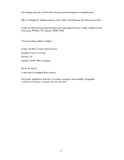Developing a genetic classification for gene pool management of spotted gums

View/
Date
02-07-13Author
Shepherd, Mervyn
Kasem, Shabana
Ablett, Gary
Ochieng, Joel
Crawford, Allison
Type
Working PaperLanguage
enMetadata
Show full item recordAbstract
Spotted gums (Genus Corymbia Section Politaria) occur as a species replacement series
along the eastern seaboard of Australia, their distributions marked by regions of
disjunction and sympatry. Their taxonomy remains controversial, with species
assignment often challenging and reliant upon knowledge of geographic origin as well
as subtle morphological or leaf oil variation. In this paper we explore a classification for
spotted gums without assuming predefined geographic or taxonomic groups, instead
using genetic structure at microsatellite marker loci (n=9) and a Bayesian model-based
clustering approach implemented in STRUCTURE software. The C. torelliana outgroup
(n=21; Section Cadagaria) formed a well resolved cluster (min. pairwise Fst = 0.19).
Four populations were evident within the spotted gums (n=93) but structure was weak
(pairwise Fst range 0.13 -0.05). Geography, both distance and topography were major
determinants of structure, with migration among populations approximating a linear
stepping-stone model. Corymbia maculata was resolved as a taxon and had the greatest
genetic distance to any other population (min pairwise Fst 0.08). Three clusters were
evident within the northern taxa but alignment with taxonomic groupings was poor.
Corymbia citriodora material from north of a major disjunction in Central Queensland
formed a Northern population. Corymbia citriodora, C. variegata and C. henryi
material from below this disjunction but north of the Border Ranges, formed a Central
population, whereas a Southern population was comprised of C. variegata and C. henryi
from predominately south of the Border Ranges. Fewer ambiguous assignments
occurred using genetic rather than taxonomic groups for self classification of the spotted
gum reference population.
